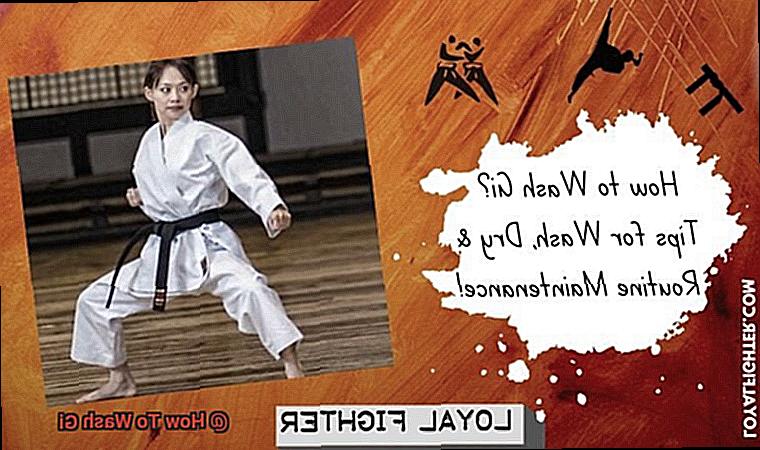Are you a martial arts enthusiast looking for advice on how to keep your Gi clean and fresh?
Washing your Gi is an essential part of martial arts instruction.
Not only does it help maintain your Gi in top shape, but it also stops the spread of germs and bacteria. Here’s what you need to know about How To Wash Gi.
First, use a mild detergent without bleach or fabric softener – these can damage the fabric. Turn your Gi inside out before washing in cold water on a gentle cycle.
Avoid using a dryer when drying your Gi – this can cause shrinkage. Hang up or lay flat after washing to prevent wrinkles.
In addition to these basic washing instructions, there are other important steps that will keep your Gi clean between washes. For example, air out after each training session by hanging outside or in an open space with good airflow.
By following these simple steps for How To Wash Gi, you can extend the life of your martial arts uniform while keeping it clean and germ-free throughout each training session.
How to Wash Gi
Step 1: Check the Care Instructions on Your Gi’s Tag

Taking proper care of your gi is essential for keeping it in top condition and making sure it lasts for years to come.
Before you start the washing process, make sure to check the tag’s care instructions – they are your guidebook for keeping your gi looking and feeling its best. These instructions will tell you whether or not to use bleach or fabric softener, as well as if your gi is pre-shrunk or not.
If it is not pre-shrunk, putting it in hot water or the dryer could lead to significant shrinkage. Additionally, many gis recommend avoiding bleach and fabric softener as they can damage the fabric or reduce its ability to absorb sweat.
Step 2: Remove Any Excess Dirt or Debris
Your gi is like a warrior’s shield, protecting you during your battles on the mats.
To keep it in pristine condition and ensure its sweat-absorbing capabilities remain optimal for years to come, it’s essential to remove any excess dirt or debris before washing. Start by shaking off the gi and brushing it lightly with a soft-bristled brush.
This helps to prevent damage to your washing machine and ensures that the gi is completely clean after washing. For any stains on the gi, pre-treat them with a stain remover or baking soda paste prior to washing.
To help lift the stain, let this sit for a few minutes before washing. If your gi is heavily soiled and stained, it may be best to wash it separately by hand before putting it in the washing machine.
This will help to remove most of the dirt and stains, so the washing machine can do its job effectively.
Step 3: Turn Your Gi Inside Out
For the ultimate protection of your gi, it’s essential to turn it inside out before washing.
This simple step helps to shield the fabric from any potential damage caused by the washing machine’s agitator, while also allowing detergent and water to penetrate more deeply for a more thorough clean. To turn your gi inside out, start by pulling the sleeves and legs of the gi to the inside of the jacket and pants respectively.
Be aware that reversing your gi after it has been washed can cause wrinkles or shrinkage in the fabric, so keep it turned inside out until it is fully dry.
Step 4: Add the Gi to the Washing Machine
If you want to keep your gi in great condition, it’s essential to wash it regularly.
Washing it in the washing machine is a cost-effective and efficient way to do this, but there are a few steps you need to take to ensure your gi doesn’t get damaged. First, check the washing instructions on your gi to make sure that it is suitable for machine washing.
Then, remove any patches or pins attached to the gi and close any Velcro straps so they don’t stick to other clothing. Before adding your gi to the machine, give the drum a thorough clean.
This will prevent any dirt or residue from sticking to your gi during the cycle. Make sure that it’s the only thing inside and use a mild detergent – no bleach or fabric softeners.
Select a delicate cycle with cold water for best results. Once finished, take out your gi from the machine and hang it outside or indoors until dry.
Do not put it in the dryer as this can cause shrinkage and damage the fabric.
Step 5: Use Cold or Lukewarm Water and a Gentle Cycle
When it comes to washing your gi, it’s essential to use cold or lukewarm water and a gentle cycle.
Hot water can cause the fabric to shrink and damage its integrity, leading to tears and holes. Similarly, a harsh cycle can cause excessive friction and strain on the fabric.
It’s also important to use a gentle, fragrance-free detergent and avoid any fabric softeners or bleach as this can reduce the gi’s durability and absorbency. To further protect the fabric, keep the wash cycle short – usually around 30 minutes should do the trick.
Step 6: Remove the Gi Promptly from the Washing Machine
When it comes to washing your gi, Step 6: removing the gi promptly from the washing machine is essential for maintaining its freshness, cleanliness, and integrity.
It’s not just about getting the dirt and grime out; it’s also about treating your prized possession with the respect it deserves. Think of separating your gi from the washing machine like taking a newborn baby out of their crib.
You wouldn’t want to leave them in there for too long, right? The same goes for your gi; you don’t want to leave it in the washing machine for too long or else you’ll end up with creases, wrinkles, and bad odors.
Not only that, but leaving your gi in the washing machine for too long will cause shrinkage or damage to the fabric. So, when it comes time to remove your gi from the washing machine, do so promptly and handle it with care.
If there are any stains that are still damp, repeat the washing process or spot treat them before drying the fabric.
Step 7: Hang Your Gi Up to Air Dry
After washing your gi, the last step is to hang it up to air dry.
This is essential for maintaining its freshness and quality over time. Make sure to hang the pants and jacket separately so that air can circulate around them easily, allowing for better drying.
Avoid using a dryer as this can cause shrinkage and damage to the fabric. If you need to wear your gi before it’s fully dry, use a fan or air conditioning to speed up the process, but make sure not to wear a damp gi for too long as bacteria growth and an unpleasant odor can occur.
Additionally, be sure to keep your gi away from direct sunlight when drying it.
Tips for Washing Your Gi
Cleaning your Gi correctly is essential for keeping it fresh, comfortable, and looking its best. Here are five tips to help you wash your Gi properly.
Care Label
Before washing your Gi, be sure to check the care label for any specific instructions. Different manufacturers may have different Gis’ instructions, so it’s important to follow them closely to avoid any damage or shrinkage.
Colors
If you have several Gis in different colors, make sure to separate them by color before washing. This will prevent any color bleeding and keep your Gis vibrant and bright.
Use a Gentle Cycle
To prevent damage or shrinkage of the fabric, use a gentle cycle when washing your Gi in a machine. A gentle cycle will also help remove dirt and sweat without being too harsh on the fabric.
Bleach and Fabric Softener
Bleach and fabric softener can be too harsh for delicate fabrics like those used in Gis, so it’s best to avoid using them entirely when washing your Gi. Stick with a mild detergent that is suitable for delicate fabrics instead.
Hang Dry
After washing your Gi, hang it up indoors away from direct sunlight or heat sources such as radiators or dryers, which may cause shrinkage or tearing of the fabric. This will also help keep your Gi looking new for longer.
JvtA50Vy9uU” >
Conclusion
Caring for your Gi is an essential part of martial arts training.
To keep it clean and fresh, and ensure its longevity, follow the steps outlined here for How To Wash Gi. First, check the care instructions on the tag.
Before washing, turn the Gi inside out and remove any dirt or debris. Use lukewarm water and a gentle cycle – avoid bleach and fabric softener as these can damage the fabric.
When finished, take it out of the machine promptly and hang it up to air dry away from direct sunlight or heat sources.






